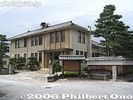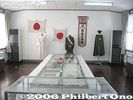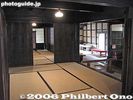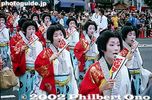 Image search results - "hachiman" Image search results - "hachiman" |

At 271 meters high, Mt.Hachiman-yama was the site of Hachiman Castle built by Toyotomi Hidetsugu in 1585. Now home to Zuiryuji temple of the Nichiren Sect, some of the castle's stone walls still remain. MAP
|
|

The 31st temple on the Saigoku (Western Japan) Pilgrimage circuit, Chomeiji (Long Life Temple) worships the Kannon goddess dedicated to long life and good health. It belongs to the Tendai Buddhist sect. This sign points the way.Accessible by bus from Omi-Hachiman Station.
|
|

Musa-juku was the sixty-sixth of the sixty-nine stations or shukuba post towns on the Nakasendo Road. It is the seventh Nakasendo station in Shiga (following Echigawa-juku in Aisho). MAPMusa was one of ten Nakasendo stations in Shiga. There is very little left. Near Ohmi Railways Musa Station, a short ride from Omi-Hachiman.
|
|

Nagahama Hachimangu Shrine torii on New Year's Day. Nagahama's most popular shrine for New Year's worship (hatsumode). MAP
|
|

Path to shrine with stone lanterns, and cars.
|
|

Stone lanterns
|
|

Every three years (2017, 2020, 2023, 2026, etc.), the full-scale version of this festival is held in mid-Aug. The festival's last day is the climax with this procession of over 50 portable shrines. Led by this banner which reads Tomioka Hachimangu.
|
|
|

Shrine priest on horseback. The start of one of Tokyo's Big Three Festivals. These photos show the festival's climax on the last day of the festival when over 50 portable shrines are paraded along the streets amid splashing water. It is the Rengo
|
|

The shrine grounds was filled with cars on New Year's Day. Apparently, the shrine has no parking lot.
|
|

Omiko shrine maidens. On the previous day during the Sacred Carriage Procession, they performed sacred dances on a truck. お巫女
|
|

Another entrance to the shrine
|
|

Tekomai geisha. Their costume is colorful and partially masculine with trousers instead of skirts. Their right shoulder is "exposed" to show a peony flower (botan) design. They carry a red paper lantern imprinted with their names.
|
|
|

Tekomai geisha. They existed since the Edo Period. They served as side entertainment at festivals. They only sing traditional chant-like songs called kiyari. 手古舞
|
|
|

This troupe of 25 local women preserve a traditional art of Edo. They attend regular singing practice led by an elderly woman who was an authentic tekomai in her day.
|
|

Haiden hall 拝殿
|
|

Hachiman-yama ropeway stationA short walk from Hachiman-bori canal.
|
|

Entrance to Chomeiji Temple. MAP
|
|

Site of Musa-juku's Honjin, the town's exclusive lodging for VIPs to stopover or rest. Only the gate remains.
|
|

Shinmachi-dori road with traditional Omi merchant homes. This area is also a National Important Traditional Townscape Preservation District (重要伝統的建造物群保存地区). 近江商人の新町通り MAP
|
|

Ice sculpture of two rats. 2008 is the year of the rat.
|
|

Okishima (Okinoshima) is Lake Biwa's largest island inhabited by over 400 residents, mainly into fishing. Short boat ride away from Omi-Hachiman's Horikiri port. MAP
|
|

This is early in the morning when the 54 portable shrines who had gathered in front of the shrine depart for the procession one after another.
|
|

In Omi-Hachiman, Shinmachi-dori looking toward Hachimanyama. This area is also a National Important Traditional Townscape Preservation District (重要伝統的建造物群保存地区).
|
|
|

Misty Horikiri Port in Omi-Hachiman. Boats leave here for Okishima island, Lake Biwa's largest island.
|
|

In front of Tomioka Hachimangu Shrine on Eitai-dori road.
|
|

Shinmachi-dori looking toward Hachimanyama
|
|

Honden Hall 本殿
|
|

Fishing boats at Horikiri Port
|
|
|
|

New Year's prayers amid snow.
|
|

Boat for Okinoshima at Horikiri Port
|
|
|

Wall
|
|

Buying omikuji fortune paper
|
|

Leaving Horikiri Port
|
|

As the mikoshi depart, there is some entertainment at the Tomioka Hachimangu Shrine.
|
|
|
|

Shrine souvenirs
|
|
|

Taiko drummers at Tomioka Hachimangu Shrine.
|
|

Local Artifacts Museum (Kyodo Shiryokan) 郷土資料館。近江商人・西村太郎右衛門の宅地跡にある資料館
|
|

Votive tablet
|
|
|

In front of the shrine, a shrine priest blesses each portable shrine as it departs to join the procession.
|
|

Shinmachi-dori next to Local Artifacts Museum
|
|
|

Misty Omi-Hachiman coast
|
|

The portable shrines are paraded through a route which will take them almost all day to complete, from 7:30 am to 3 pm.
|
|

Local Artifacts Museum (Kyodo Shiryokan). Former residence of Omi merchant Nishimura Tarouemon. 郷土資料館
|
|
|
|

The mikoshi are splashed with water in whichever way possible. This is in the middle of summer, so it's a good way to cool off.
|
|

Inside Local Artifacts Museum (Kyodo Shiryokan)
|
|

Torii to Benzaiten Shrine
|
|
|

Each mikoshi is preceded by a row of women carrying lanterns and wands. Also see the video at YouTube
|
|

Hachiman-yama ropeway takes only 4 min. to go up
|
|
|

Musa's Honjin
|
|

Inside Local Artifacts Museum (Kyodo Shiryokan)
|
|

Benzaiten Shrine
|
|

Okinoshima in sight
|
|

People in happi coats carry the mikoshi while shouting "Wasshoi, wasshoi!"
|
|

Connected to the Local Artifacts Museum is the History and Folklore Museum (Rekishi Minzoku Shiryokan) 歴史民族資料館
|
|

Benzaiten Shrine
|
|

Misty Okinoshima
|
|
|

Standard uniform of portable shrine bearers (for both men and women).The headband may be tied at the front or back of the head. It may also be tied on the head like a bonnet. There is a variety of ways of tying the headband.
The happi coat bears the name of the parish or district the person belongs to. The same name is displayed on the respective portable shrine. The shorts are white and skintight. Worn by both men and women. Also called Han-momo or Han-momohiki. The white tabi (sock-like shoe) has a rubber sole.
|
|

Soldier's uniform, History and Folklore Museum
|
|

Torii to Tenmangu Shrine 天満宮
|
|

Entering Okinoshima Port. Okishima is the largest island in Lake Biwa. MAP
|
|

History and Folklore Museum
|
|

Tenmangu Shrine 天満宮
|
|
|
|

Soldier's send-off flag, History and Folklore Museum
|
|

Omikuji tied on tree branches
|
|

Side of boat
|
|
|

Omi merchant daily implements, History and Folklore Museum
|
|
|
|

Okinoshima Port
|
|

"Hey Ho, Let's Go!"
|
|

Omi merchant house, History and Folklore Museum
|
|

Fire bringing warmth
|
|

Okinoshima Port and boat schedule
|
|
|

Omi merchant furniture, History and Folklore Museum
|
|
|
|

Okishima Port
|
|
|

This mikoshi is being carried by all women, already soaked to the bone. They carry the mikoshi flat on their shoulders. This is called "Hira katsugi," literally "flat carrying."There are four basic methods of carrying a portable shrine. This is the most basic method where they carry it flat on their shoulders. This is called "Hira katsugi," literally "flat carrying."
|
|

Omi merchant furniture, History and Folklore Museum 近江商人の帳場風景
|
|

Basho haiku monument
|
|

Sea wall
|
|

Splash you. This is a day when kids can be mean to grown-ups. This little girl kept filling up her bowl and ran around splashing some unlucky person.I hope that's her school teacher.
|
|

Omi merchant desk, History and Folklore Museum 近江商人の帳場風景
|
|
|

808 steps to Chomeiji. Chomeiji (Long Life Temple) worships the Kannon goddess dedicated to long life and good health. It belongs to the Tendai Buddhist sect.
|
|
|

Honjin sign
|
|

Former Ban family Omi merchant home which also served as a girls school and public library until 1997. Omi-Hachiman, Shiga. 旧伴家住宅Opened to the public in 2004 as a museum. 伴庄右衛門は江戸時代初期から活躍した八幡商人の一人で、屋号を扇屋といい、主に畳表・蚊帳を商い豪商となった。
|
|
|

Water splashing truck near Kiyosu-bashi Bridge
|
|

Entrance to former Ban family residence. Completed in 1840. 旧伴家住宅伴庄右衛門は江戸時代初期から活躍した八幡商人の一人で、屋号を扇屋といい、主に畳表・蚊帳を商い豪商となった。
|
|

Shore road
|
|

Water hose at Kiyosu-bashi Bridge
|
|

Inside former Ban family residence. They made their fortune selling mosquito nets and tatami straw matting.
|
|

Steps to the larger hill
|
|

Crossing Kiyosu-bashi Bridge over Sumida River.
|
|

Inside former Ban family residence.
|
|

Neck of Okishima.
|
|

Crossing Kiyosu-bashi Bridge
|
|

Inside former Ban family residence, 2nd floor.
|
|

Okinoshima Port
|
|

Crossing Kiyosu-bashi Bridge
|
|
|
|

Narrow alley
|
|

Raising the mikoshi on Kiyosu-bashi Bridge
|
|

Crossing Kiyosu-bashi Bridge. They chant "wasshoi wasshoi!" as they carry the mikoshi. 清洲橋
|
|

Former Nishikawa Residence (Kyu-Nishikawa-ke Jutaku), large Omi merchant home designated as an Imnportant Cultural Property. Omi-Hachiman, Shiga. 旧西川家住宅 国重要文化財
|
|

Renmyo was here.
|
|

Crossing Kiyosu-bashi Bridge
|
|

Entrance to Nishikawa Residence. During the Edo Period, the family made their fortune selling mosquito nets and tatami straw matting.
|
|
|
|

Wall of Nishikawa residence.
|
|
|
|

Inside Nishikawa residence. Omi-Hachiman, Shiga. 国重要文化財畳表や蚊帳を扱っていた江戸時代の豪商・西川利右衛門の旧宅
|
|
|

With raised arms, this is one way to carry the mikoshi.
|
|
|
|
|

Hatago inn called Nakamura-ya, this was the only remaining inn in Musa-juku. Unfortunately, this inn was destroyed by an early morning fire on Dec. 10, 2010. No one was hurt. The inn owners were sleeping on the 1st floor and they escaped.
|
|

Nishikawa residence.
|
|
|

A horde of people follow each portable shrine.
|
|

Nishikawa residence.
|
|

Leaving Okinoshima (we'll be back).
|
|
|

Business diary
|
|
|
|

Nishikawa residence.
|
|

Misty Omi-Hachiman coast
|
|
|

Nishikawa residence.
|
|
|

Phoenix atop a portable shrine.
|
|

Nishikawa residence.
|
|
|

Kiyosu-bashi Bridge over the Sumida River, Important Cultural Property 清洲橋 国の重要文化財
|
|

Nishikawa residence.
|
|
|

Crossing over Eitai-bashi Bridge. 永代橋
|
|

Tekomai geisha cross Eitai-bashi Bridge to enter Koto Ward along Eitai-dori.
|
|

手古舞
|
|

Tekomai geisha at Eitai-bashi
|
|
|

Hachiman-yama map
|
|

Inn sign. The 200-year-old Nakamura-ya inn burned down on Dec. 10, 2010.
|
|

Tekomai geisha at Eitaibashi
|
|

Tekomai geisha
|
|

They sing and chant while walking slowly.
|
|
|
|
|

They have flower hats, but I've never seen them wear it on their heads.
|
|

Tekomai geisha on Eitai-dori road, entering Koto Ward
|
|

They do not get water splashed.
|
|
|
|
|
|
|

Musa-juku 武佐宿
|
|

A portable shrine crosses Eitai-bashi Bridge.
|
|

A portable shrine crosses Eitai-bashi Bridge.
|
|

Another portable shrine crosses Eitai-bashi Bridge.
|
|

Using a water hose is an efficient way to get people wet. But see what the big boys use..
|
|

A fire hose. The local fire department with a fire hose on Eitai-dori avenue.
|
|

The water hose is now handled by volunteers, not real firemen.
|
|

Every time, the water hoses are at the same location.
|
|

Water spray
|
|
|

Wet face
|
|

Hiroshige's woodblock print of Musa-juku (67th post town on the Nakasendo) from his Kisokaido series. A bridge of boats.
|
|
|
|
|

Crowd on Eitai-dori road
|
|

After crossing Eitai-bashi Bridge, the portable shrines headed for the main stretch on Eitai-dori avenue already filled with people. The wettest and most crowded part of the festival is held along this one kilometer of road between the bridge and shrine.
|
|
|

This is the final stretch and wettest part of the festival.
|
|

Prepared for the water...
|
|

A large truck filled with water with people using buckets to splash water in rapid succession.
|
|

View from behind the "water truck." This goes on for about 15 seconds. The truck is refilled with a fire hose. All in the name of purification.
|
|

During a break, two kids get water.
|
|
|
|

Halfway point and rest stop
|
|
|
|

Fukagawa Hachiman Matsuri, mizu-kake
|
|

The mikoshi is raised high as they all bathe in water. Taking photos like this one requires adequate water protection of your camera and lens.
|
|
|

Onegaishimasu! お願いします!
|
|

Hai, OK (ha-ha!).
|
|

For some reason, it's fun to see people get wet...
|
|

Getting wet upside down might be an extra thrill...
|
|

In front of the water truck. Soon to be filled with people and a portable shrine.
|
|
|
|
|

Onegai Jizo-do Hall おねがい地蔵堂
|
|
|

My video of a water truck splashing water on mikoshi.
|
|
|

Wet women
|
|

Large crowd watch the mikoshi parade near Tomioka Hachimangu Shrine on Eitai-dori road.
|
|
|
|
|

Hand clapping
|
|

The tekomai geisha arrives at Tomioka Hachimangu Shrine.
|
|

The tekomai geisha enter the shrine.
|
|

The tekomai geisha enter the shrine.
|
|
|
|
|
|

The tekomai geisha enter Tomioka Hachimangu Shrine.
|
|

As the portable shrines reach the shrine, they give one last show before returning to their parish.
|
|

My video of Fukagawa Tekomai performing at Kiba Park in Oct.
|
|

Tossing a mikoshi.
|
|

The portable shrine gets a final mid-air toss while passing by Tomioka Hachimangu Shrine. This mid-air toss of the portable shrine is called "mai-age" or tossing up.
|
|

Crowd at the shrine entrance.
|
|

One after another, the mikoshi arrives in front of the shrine.
|
|

And give their last show.
|
|
|
|
|
|
|

Being at the shrine's torii entrance is a great place to watch the mikoshi.
|
|
|
|
|
|
|
|
|
|
|

Dramatic display of mikoshi maneuvers
|
|

The shrine's happi coat has a design for the character "Hachi" (for Hachimangu) consisting of two pigeons. Pigeons are regarded as the messengers of the deity worshipped at Hachimangu shrines in Japan.
|
|

The steps never seem to end...
|
|
| 1702 files on 7 page(s) |
1 |
 |
 |
 |
 |
|